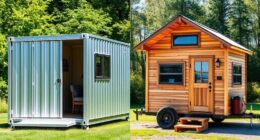To prune trees effectively on small properties, focus on removing dead, broken, or diseased branches first. Make clean cuts just outside the branch collar using sharp tools like pruning shears or loppers. Use the three-cut method for larger branches to prevent tearing. Light, strategic pruning maintains shape and controls size without stressing the tree. Proper pruning improves health and safety, and if you keep exploring, you’ll discover even more tips for flourishing trees.
Key Takeaways
- Focus on light, strategic cuts to maintain shape and control size suitable for small properties.
- Use sharp, clean tools like pruning shears and loppers for precise, healthy cuts.
- Remove dead, diseased, or damaged branches first to promote overall tree health.
- Make cuts just outside the branch collar to encourage quick healing and reduce pest entry.
- Prune more frequently to manage growth, prevent interference with structures, and maintain safety.

Tree pruning is an essential practice for maintaining healthy and attractive trees, and understanding the right techniques can make a significant difference. When you focus on proper pruning, you’re actively supporting the tree’s overall health and ensuring it grows safely within the confines of your small property. The foundation of effective pruning lies in understanding how to enhance tree health, which involves removing dead or diseased branches and promoting good airflow and sunlight penetration. Using the right pruning tools is crucial here; sharp, clean tools like pruning shears, loppers, and saws help you make precise cuts that minimize injury to the tree and reduce the risk of infection.
Proper pruning supports tree health with sharp tools and strategic cuts.
When you start pruning, you should always aim to remove any dead, broken, or diseased branches first. These compromised parts can harbor pests or fungi that threaten the overall health of your tree. By cutting these out, you prevent potential spread and give the tree a better chance to thrive. Make sure your pruning tools are sharp, as dull blades can crush or tear branches, which hampers healing and invites disease. Proper tool maintenance is essential—clean your tools after each use to avoid transferring pathogens from one part of the tree to another.
Next, focus on making clean cuts at the right locations. For branches, cut just outside the branch collar—the swollen area where the branch connects to the trunk or another branch. This not only helps the tree heal faster but also encourages proper growth. Avoid leaving stubs, as they can become entry points for pests and diseases. When removing larger branches, use a three-cut method: first, make a small cut on the underside of the branch to prevent tearing; second, make a cut further out to remove the weight; finally, prune the remaining stub at the branch collar. This technique reduces the risk of damaging the trunk or the remaining branch.
In small properties, you may need to prune more frequently to keep trees manageable and healthy. Regular maintenance allows you to control growth, shape the tree, and prevent it from interfering with structures or power lines. Always remember that less is often more; aggressive pruning can stress the tree and impair its health. Instead, focus on light, strategic cuts that support the tree’s natural form. Additionally, educating yourself about digital literacy and safety can help you use online resources effectively for learning about tree care and pruning techniques. With proper understanding of pruning techniques, the right tools, and attention to tree health, you’ll keep your small property’s trees vibrant, safe, and flourishing for years to come.
Frequently Asked Questions
What Tools Are Best for Pruning Small Trees?
You should use pruning shears or loppers for small trees, as they give precise cuts and are easy to handle. If branches are thicker, a small hand saw works well. Always prioritize power tool safety by wearing gloves and eye protection, and keep your tools sharp and clean for effective pruning. Regular pruning tool maintenance guarantees your tools stay in good shape, making your work safer and more efficient.
How Often Should I Prune My Small Trees?
Did you know that proper pruning can boost a tree’s health and growth by up to 20%? For small trees, you should prune about once a year, focusing on seasonal timing—preferably late winter or early spring before new growth starts. Regular pruning encourages strong structure and disease resistance. Keep an eye on your trees’ growth, and adjust pruning frequency if you notice overgrowth or dead branches to keep them healthy and safe.
Can Pruning Help Prevent Tree Diseases?
Pruning definitely helps prevent tree diseases by removing dead, diseased, or weak branches that can harbor pathogens. When you prune regularly, you promote healthy growth and improve air circulation, which reduces moisture buildup and fungal risk. This proactive approach keeps your trees stronger and less susceptible to infections, ensuring they stay healthy longer. Proper pruning is a key part of disease prevention and maintaining vibrant, resilient trees on your small property.
Is DIY Pruning Safe for Small Property Trees?
DIY pruning can be safe if you follow proper safety precautions and have some pruning certifications or training. Always wear protective gear like gloves and goggles, and use sharp, appropriate tools to avoid accidents. Know the correct pruning techniques to prevent damaging your trees. If you’re unsure or dealing with large branches, it’s best to hire a professional. Prioritize safety and proper knowledge to keep your small property trees healthy and safe.
When Is the Ideal Time of Year to Prune?
You should prune trees in late winter or early spring, when about 50% of the trees’ growth cycle is complete. This timing encourages healthy growth and minimizes disease risk. Seasonal considerations are essential, as pruning during dormancy reduces stress on the tree. Remember, proper timing supports ideal growth, so plan your pruning when trees are least active, typically before buds swell and new growth begins.
Conclusion
So, now you’re practically a tree whisperer, armed with pruning secrets for small properties. Remember, a little snip here and there keeps your trees happy—just don’t turn into the neighborhood’s top chainsaw artist. With these techniques, you’ll impress your neighbors with a yard so tidy, even the trees will thank you. Just don’t forget: pruning isn’t magic, it’s just you pretending you’re a professional while secretly hoping no one notices your shaky hands. Happy trimming!









